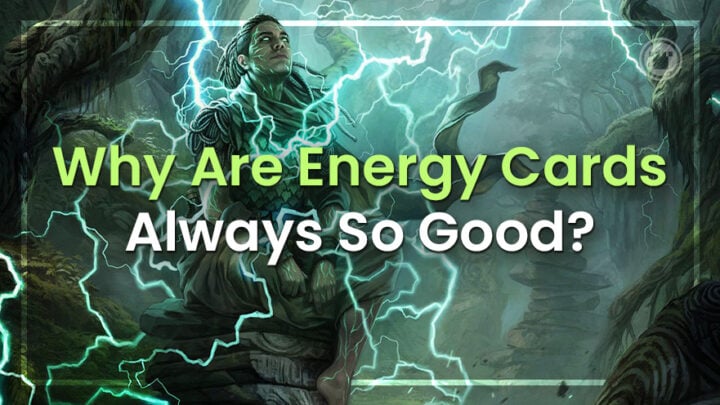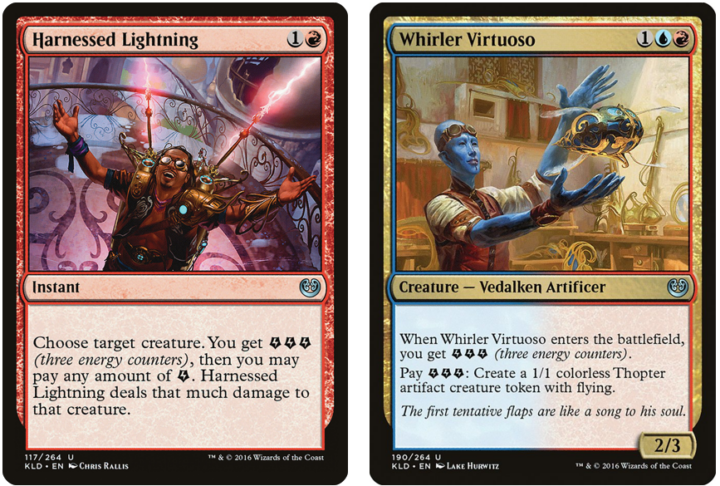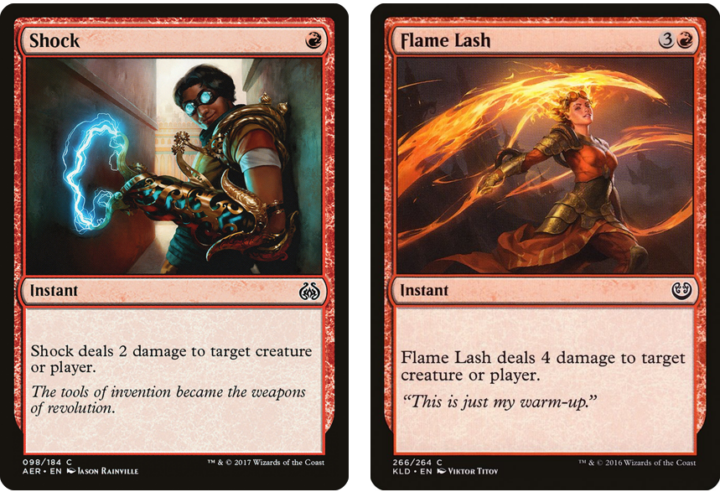Aetherdrift spoiler season is off to the races, and as we get a closer look at some of the mechanics that power this high-octane set, one returning design is bound to raise eyebrows. Aetherdrift is sort of a “Return to Kaladesh” in both lore and themes, and we can now confirm that inheritance extends to the reintroduction of energy cards!
For Commander players energy never went away completely, but this will be the first time we’ve seen it in Standard since Kaladesh block, when four-color energy decks all but monopolized the metagame. Its only other Constructed appearance was in Modern Horizons 3, where the energy cards again instantly became the core of a new, dominant archetype.
So it’s understandable why players who’ve seen what energy does to a format might be trying to slam the brakes or reach for an ejector seat about now. But how likely are we to see a repeat of these mistakes? Why do energy decks seem so much better than everything else? Is this mechanic inherently broken, or do we just need to change how cards are using it?
CAR-RACING SET, MEET THE SELF-DRIVING MECHANIC
Despite the hyperbolic language we all love to use when discussing mechanics like energy online, it’s very hard to prove that one mechanic is inherently more powerful than another, because they only exist in the context of the cards they’re used on.
We tend to conflate our opinions of those things and make sweeping statements about mechanics based on their most recent or infamous appearances in the metagame. But even for cases like storm where a mechanic is widely agreed to be unhealthy, it’s not that difficult to create new cards which use that same mechanic in healthy ways.
Likewise, even for mechanics which are generally considered weak and old fashioned, there are some cards which use them and are extremely potent. It’s an important distinction to make, because if a mechanic is not inherently broken in all cases (and very few are) then you can make the case for a new set figuring out how to implement them in a way which avoids the pitfalls of previous overpowered designs.
I was very skeptical about bringing back poison counters and phyrexian mana in 2023, but all it took to fix those was limiting phyrexian costs to activated abilities and making creatures deal a fixed amount of poison damage instead of tying it to power. I’m not excited by the prospect of writing a second crow-eating blog in as many years, so you’ll forgive me if I don’t rush into writing off energy completely.
For all that clever rhetoric though, I can’t deny that certain mechanics seem to be objectively more volatile and harder to balance – and energy is in that club with the likes of storm, affinity and dredge. What those mechanics have in common is a very potent and consistent internal synergy: every card gets better for every other card with the mechanic you put in your deck.
Obviously at a surface level almost every set mechanic works this way: once you start building around a theme like spellslinger or cat typal or domain, and choosing spells which support or are empowered by that theme, you may as well add more.
But usually the cards within an archetype have a defined role: Arahbo, the First Fang and Skyknight Squire are payoffs for a go-wide Cats deck in Standard, while Helpful Hunter and Prideful Parent are the glue cards which enable them. Each of those cards gets better as you add more copies of the others, but when evaluating different draws or game planning to attack the deck they are not equivalent.
With energy and these other high-powered cases, you have a mechanic which blurs those lines and smooths out a lot of the potential variance between draws. The inherent flexibility of energy means you don’t need to think as much in terms of specific card combinations – you just need your draw to hit a certain total threshold of energy, which you can number-crunch with a similar kind of consistency to manabases.
Your deck probably does have specific outlets you’d prefer that energy to go to for securing a win. But the big advantage is that you don’t ever need to compromise between that on-paper gameplan and the needs of the moment.
Your Harnessed Lightning is always going to take up as much (or as little) of your energy reserve as it needs to answer that must-kill threat. You aren’t putting Whirler Virtuoso in the deck as a primary energy sink, but if your opponent passes turn in a spot where dumping everything into thopters will give you on-board lethal, you’re free to do that. It’s a level of consistency through redundancy and fine-grain control that very few other mechanics allow – if any.
IT’S LITERALLY A SYNONYM FOR “POWER”
We’re some years on from Aether Revolt now – years which contained the panics over Ramunap Red, Oko & Uro UG, and the companion rule – yet nothing else has seemed to damage Standard as badly as the energy deck meta. Certainly Wizards reacted more strongly to this crisis than we usually see, and part of that was taking the new and volatile energy mechanic off the table for a little while.
When they did decide to experiment with tournament energy decks again, I think it’s telling that they did so in the much larger, deeper shark tank that is Modern. “Okay,” they seemed to say, “we realize that the inherent power and synergy of energy decks will be too much for other Standard archetypes. But it’ll be a different story in Modern, where the other decks are combining the A-list cards from decades of sets and have their own broken synergies to leverage!”
But when they re-introduced energy through Modern Horizons 3, it looked more or less the same as Kaladesh block. The biggest difference was that the best energy cards were no longer multicolor midrange pieces, so there was less opportunity for them to coalesce into a single homogenous archetype.
Other than that, it was more or less the same dominance as in Standard: Boros energy and its three color variants immediately shot to the top rank for both usage and winrate, the various build-around energy cards all proved to be at least viable, and even control decks adopted the new energy-based interaction.
Perhaps in hindsight the idea that energy would be challenged by the overall power of Modern was undercut somewhat by printing all these new Modern-tier energy spells that players could immediately combine to get that inherent flexibility buff. But I don’t think being flexible was the only thing that helped MH3 Boros Energy take off like it did. Energy and those other famous “broken” mechanics are incredibly good at creating the most important advantage in competitive Magic – tempo.
My best quick definition of tempo is “generating more value from your available mana than your opponents within a turn cycle or other window of time”. For Standard decks like mono-blue or mono-red, this often means playing a lot of cheap cards with immediate impact, since four one-mana spells add up to more impact than one four-mana spell.
Filling your deck with cheap, generically useful spells also ensures you can curve out and not leave mana on the table for want of the right opportunity – it’s hard to not find something to do with a handful of Lightning Bolts. Looking back to our main topic, I don’t think it’s a huge leap to argue that the energy mechanic itself replicates the advantages of this playstyle independently of your actual mana curve.
Normally the tempo battle is all about how to best use your mana within each turn, since whatever you can’t spend now is going to waste. But now one deck is effectively converting most of its mana into this second, independent resource, which is almost as flexible in what it can buy but which DOESN’T have that tricky “use-it-or-lose-it” restriction.
Now your control deck can contest the early board with some basic blockers and spot removal, bank up the energy they generate, and cast a two-mana Wrath of the Skies that hits like you paid five mana. That three extra mana you didn’t have to actually pay can now be spent on a threat like Teferi or Phlage, double-spelling way ahead of what would normally be possible with basically no downside.
Those other volatile mechanics like dredge and storm have their own ways to shatter underlying assumptions about the tempo of a match, but none are quite as blatant – or as versatile – as “having a second, cooler mana pool”. It’s just another aspect of this mechanic which sets it apart and ahead from the rest of Magic.
THE SUSTAINABLE ENERGY REVOLUTION
So far I’ve tried to simply explain the traits and impact of previous energy decks, without passing judgement on the mechanic or the decision to put it in Aetherdrift. But that doesn’t mean I don’t have a strong opinion – I just didn’t want it to color the explanation for people who might be approaching this debate for the first time.
Spoiler season comment threads are difficult terrain for hosting reasonable discussions around balance, but I think having those sorts of discussions is useful even if nobody from Wizards R&D is lurking to read them. If more players spent more time thinking about how “broken” cards and mechanics actually impact the play experience, playing or talking about Magic with strangers could be much more pleasant.
I played on the non-energy side of both the Constructed metagames just discussed, and I had just as hard a time containing those dynamic archetypes as everyone else. I don’t even own an energy deck for Commander. But I do think we should design the game so players have more chances to make interesting plays. I have also written plenty about how the overwhelming pressure on constructed decks to optimize mana use takes those choices away.
From that perspective, I think energy is an amazing mechanic which represents a much better potential future for Magic design. It’s just a shame that it’s so difficult to balance against decks without energy. There’s a better timeline out there where Richard Garfield invents energy back in 1993, and this resource becomes as universal to the game as tapping or sacrificing cards.
Since we can’t put this djinni back in that bottle though, I hope that Wizards puts on their thinking caps and figures out how to make energy cards in a way that constrains some of those automatic advantages, just as they did with those “broken” phyrexian mechanics before.
Try printing more cards which are exclusively generators or users of energy instead of everything being both. Design abilities that cost energy so that there’s a soft (or hard) cap on how much energy can be efficiently spent through them.
Most of all, don’t allow cheap, generic spells to generate multiple excess energy while still impacting the board! The new Harnessed Lightning/Galvanic Discharge type spells should make you choose between spending and producing energy. “Normal” Magic decks will naturally create inefficient moments where you spend a three-damage spell on a one-toughness creature, so you need to force energy decks to deal with some occasional inefficiency by design.
I firmly believe that by forcing energy decks to make a few more tough decisions with their special resource, you can bring them back to an even playing field with everything else. The fact Wizards were willing to let the mechanic ride again makes me hopeful they feel the same, and that this time the energy decks will be just one more cool flavor in a balanced and diverse Standard environment.

Tom’s fate was sealed in 7th grade when his friend lent him a pile of commons to play Magic. He quickly picked up Boros and Orzhov decks in Ravnica block and has remained a staunch white magician ever since. A fan of all Constructed formats, he enjoys studying the history of the tournament meta. He specializes in midrange decks, especially Death & Taxes and Martyr Proc. One day, he swears he will win an MCQ with Evershrike. Ask him how at @AWanderingBard, or watch him stream Magic at twitch.tv/TheWanderingBard.







